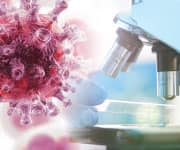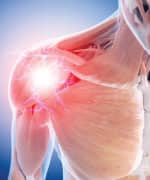Life Extension Magazine®
Life Extension® long ago observed older people who are “on fire” as a result of uncontrolled inflammatory reactions.
Inflammation causes or contributes to development of:
- Cancer
- Dementia
- Atherosclerosis
- Frailty
- Arthritis
- Other degenerative disorders
Normal aging is often accompanied by increased systemic inflammation.
This is evidenced by higher levels of inflammatory blood markers in elderly persons,1 as well as outward symptoms like persistent pain.
Today’s consensus is that chronic inflammation is significantly involved with degenerative aging.2
Our ability to fully resolve stubborn inflammation diminishes in older age, thus worsening the systemic problems to which it contributes.3,4
Nutrients such as curcumin inhibit inflammation and reduce its severity.
Although inhibiting the onset of inflammation is important, emerging scientific research suggests this is only half of the equation. Resolution of inflammation may be as important as inhibition of inflammation.
Resolution of inflammation is an active, critical process that demands factors called specialized pro-resolving mediators (SPMs) to optimally manage the inflammatory process.
To this end, groundbreaking research has uncovered a method to resolve inflammation and return tissues to a healthier and more youthful function .5-7
An Insidious Culprit

As we age, the risk of degenerative disease increases.
A central factor in age-associated illness is chronic inflammation. Many diseases of aging are closely linked with loss of youthful cellular function, and can be traced back to persistent and unresolved inflammatory reactions.2,3
Inflammation can be initiated and exacerbated in many ways including poor diet, environmental toxins, cigarette smoke, excess body weight, and aging (the term for this is inflammaging).
Senescent cells that accumulate with age release compounds that promote and maintain an environment of chronic inflammation.2,8-10
Some inflammatory reactions, such as cartilage destruction in joints, lead to outward symptoms like pain.
Curcumin and SPMs: A Powerful One-Two Punch
Specialized pro-resolving mediators (SPMs) are naturally occurring fatty acids available in supplement form.
While SPMs can be used alone, taking them with other nutrients can provide optimal support.
Nutrients like curcumin have been shown to inhibit the initiation and reduce the severity of inflammation.
SPMs, on the other hand, actively help resolve ongoing inflammation.
By combining the use of nutrients like curcumin that help inhibit inflammation, and SPMs that help actively resolve ongoing inflammation, the detrimental effects of chronic inflammation can be mitigated.
Chronic inflammation

Inflammaging, however, may be silent and insidious. This is particularly troublesome with vascular inflammation, with no obvious warning signs until heart attack or stroke occurs.
Over time chronic inflammation damages cells, organs, and blood vessels, which leads to loss of function and exacerbates risk of common, age-related health problems.2,8-11
What you need to know
- Chronic inflammation is a major contributor to almost every age-related disease and is a key cause of the aging process itself.
- Long thought to be a passive process, the resolution of inflammation is now known to be an active process, requiring several fatty-acid-derived compounds known as specialized pro-resolving mediators (SPMs).
- These SPMs remove dead and dying cells and debris left over from inflammation, restore a healthy balance of pro- and anti-inflammatory mediators, and renew tissues by initiating healing and regeneration.
- In both animal and human models, aging is associated with dysfunctional SPM pathways, which in turn have been implicated in several age-related disorders. Higher SPM levels appear to be protective against these age-linked diseases.
Resolving Chronic Inflammation
Some dietary components like curcumin and ginger, and drugs like NSAIDs, inhibit and/or reduce the severity of inflammation. They do this by blocking the onset (or induction) of inflammation by reducing the production of compounds that start the inflammatory process.
Inhibiting the start of inflammation, however, is very different from facilitating the resolution of inflammation.
In the past, the resolution of inflammation was believed to be a passive process. This was incorrect.
Emerging scientific advances demonstrate that the resolution of inflammation is a dynamic, active process requiring specialized factors that facilitate resolution.
In a major finding, scientists have identified these specialized factors as lipid-based compounds that actively bring about the resolution of inflammation.
These compounds are called specialized pro-resolving mediators or SPMs.
Derived from specific types of polyunsaturated fatty acids, SPMs bind to specialized receptors on cells, organs, and blood vessels, actively helping to resolve the inflammatory process and allow the healing and regeneration of damaged tissues.
The Power of Specialized Pro-Resolving Mediators

SPMs (specialized pro-resolving mediators) fall into several inflammation-resolving sub-classes, and together, these SPMs can resolve inflammation and return tissues to normal function.
They accomplish this by their ability to do three vital tasks:5-7
- Remove. SPMs activate macrophages, which are immune system cells that remove the mess left behind from inflammation, including dead and dying cells and cellular debris. This cellular garbage must be cleaned up if healthy, surviving cells are to make a full recovery of function.
- Restore. SPMs restore the healthy balance of inflammatory compounds in the tissue, reducing the pro-inflammatory mediators while increasing compounds that have anti-inflammatory activity.
- Renew. They initiate and promote regeneration of tissues that have been disrupted or damaged by inflammation.
The ability to resolve inflammation efficiently diminishes in older age, worsening the problem of inflammaging.3,4
A few examples of the importance of SPMs in resolving inflammation include published studies showing:
1) Reduced or dysfunctional SPMs found in the brains of mice and humans with Alzheimer’s disease.12,13
2) Defective SPM resolution linked to the progression of atherosclerotic plaque and therefore, cardiovascular disease.14
3) Abnormalities of SPMs observed in conditions of insulin resistance like metabolic syndrome, as well as obesity.15-18
Anti-Inflammatory Compounds + SPMs as Adjuvants to Cancer Treatment
Surgery to remove malignant tumors and chemotherapy both aim to dramatically reduce the burden of cancer cells in the body. However, treatments such as these have the downside of stirring up inflammation in the area of the tumor, which can contribute to progression of the tumor and subsequent local recurrence or metastases.
Many years ago, Life Extension recognized the contribution that inflammation makes to the progression of cancer. At the time, we recommended anti-inflammatory treatments, such as Lodine® (etodolac), a potent, non-steroidal anti-inflammatory drug (NSAID), as an adjuvant to other cancer therapies, to help reduce the risk of tumor recurrence and poor outcomes.
A recently published study has just validated this protective effect of anti-inflammatory therapies and took it a step further.30 In animal models of cancer, administration of an NSAID medication (in this case ketorolac) and resolvins (a group of specialized pro-resolving mediators) before surgery or chemotherapy, prevented treatment-induced tumor progression. These two treatments had synergistic effects, maximizing each other’s anti-cancer activities, and that led to superior long-term survival.
How to Increase SPM Activity
Inspired by these findings, scientists sought to find a way to increase the presence of specialized pro-resolving mediators (SPMs) in the body, especially for aging individuals.
Researchers identified the specific SPM fatty acids due to their distinct bioactivity and their ability to effectively resolve ongoing inflammation. These natural, polyunsaturated, fatty acids are stable precursors to a wide array of different types of SPMs.7
SPMs help resolve inflammation and restore tissue function.
They do this via mechanisms different from anti-inflammatory nutrients and drugs that inhibit inflammation.
By providing these compounds to the body, the goal is to aid in the resolution of chronic inflammation, a critical component of any longevity regimen.
Harvard Magazine Publishes article about SPMs
A Harvard Magazine article published in 2019* noted the work of Dr. Charles Serhan and other scientists who are doing research on resolving and reversing inflammation. “In experiments with animals deficient in SPMs [specialized pro-resolving mediators], Serhan has shown that injecting SPMs amplifies the magnitude of the healing response, causing injuries to mend more quickly,” the author stated.
He went on to say that, “The SPMs instead work in concert with the immune response.” They do this, according to Dr. Serhan, by stimulating macrophages, “to clear dead cells, debris, and bacteria. Then they bring the system back to homeostasis and begin to push the buttons to signal tissue regeneration.”
*Shaw J. Raw and Red-Hot: Could inflammation be the cause of myriad chronic conditions? Harvard Magazine, May-June 2019.
New SPM Studies

The use of SPMs to treat disease and delay aging is cutting-edge science.19
Although the understanding of these natural fatty- acid compounds has been evolving for some time, the results of animal and human studies that demonstrate their impact on disease are relatively recent.
In an animal model of osteoarthritis, supplementation with a specialized pro-resolving mediator (SPM) known as 17-HDHA, eliminated pain-linked behavior.20
In humans suffering from the same joint disease, higher blood levels of 17-HDHA correlated with less pain.21 These data suggest that systematically boosting levels of this SPM in the body may be a powerful tool to help resolve localized joint inflammation and pain.
Emerging research suggests that failure to effectively resolve inflammation is a key component in the development of age-related cognitive decline and Alzheimer’s-type dementia. Studies have identified dysfunctional SPM pathways in Alzheimer’s disease progression.
In an animal model of dementia, the SPM resolution responses were blunted, the likely factor for the observed decline in brain function.12
In humans, postmortem analysis of brain tissue from Alzheimer’s patients suggests that the inflammation resolution pathway is dysfunctional compared to healthy brain tissue.13
The mouth is a common site of chronic inflammation, even with adequate dental hygiene. This can contribute to halitosis (bad breath), damage to teeth and gums (periodontal disease), and even systemic inflammation.
In experimental models, topical oral treatment with SPM resolvins helped diminish inflammation and initiate regeneration of bone, gums, and teeth that had been damaged.22,23
Other studies suggest that abnormalities in SPM pathways play a role in chronic diseases that have inflammation as a component, including kidney failure, liver impairment, diabetes, obesity, atherosclerosis, and coronary heart disease.14-16,24-29
Inflammation Resolution
SPMs are specialized pro-resolving mediators.
As their name implies, they don’t inhibit inflammation—they initiate the resolution of inflammation.
There is growing consensus that specialized pro-resolving mediators can be a potent longevity intervention.19
Scientists have identified and isolated three important SPMs that may help the body safely resolve chronic inflammation and thereby reduce the damage of aging.
While SPMs can be used alone, by combining the use of curcumin (inhibit inflammation) and SPMs (resolve inflammation), inflammation can be effectively knocked out.
Curcumin blocks the initiation and reduces the severity of inflammation. SPMs take the next step and resolve it, allowing tissues to restore themselves and function in a healthy manner.
Summary
Inflammation that remains ongoing and unresolved inflicts damage that contributes to accelerated aging and most degenerative disorders.
Nutrients like curcumin and ginger inhibit the onset of inflammation and help reduce the intensity of inflammation.
Older individuals, however, often need to better resolve inflammation in order to return tissues to more youthful function.
New research indicates that active resolution of inflammation can be accomplished with unique compounds known as specialized pro-resolving mediators (SPMs).
Ongoing research indicates that these SPM compounds are critical for the resolution of active inflammation and the restoration of tissue health.
Additional findings suggest that many age-related diseases are linked with insufficient or inadequate SPM activity.
If you have any questions on the scientific content of this article, please call a Life Extension® Wellness Specialist at 1-866-864-3027.
References
- Velissaris D, Pantzaris N, Koniari I, et al. C-Reactive Protein and Frailty in the Elderly: A Literature Review. Journal of clinical medicine research. 2017;9(6):461-5.
- Franceschi C, Campisi J. Chronic inflammation (inflammaging) and its potential contribution to age-associated diseases. J Gerontol A Biol Sci Med Sci. 2014 Jun;69 Suppl 1:S4-9.
- Rea IM, Gibson DS, McGilligan V, et al. Age and Age-Related Diseases: Role of Inflammation Triggers and Cytokines. Front Immunol. 2018;9:586.
- Arnardottir HH, Dalli J, Colas RA, et al. Aging delays resolution of acute inflammation in mice: reprogramming the host response with novel nano-proresolving medicines. J Immunol. 2014 Oct 15;193(8):4235-44.
- Serhan CN. Pro-resolving lipid mediators are leads for resolution physiology. Nature. 2014 Jun 5;510(7503):92-101.
- Serhan CN. Treating inflammation and infection in the 21st century: new hints from decoding resolution mediators and mechanisms. FASEB J. 2017 Apr;31(4):1273-88.
- Serhan CN. Discovery of specialized pro-resolving mediators marks the dawn of resolution physiology and pharmacology. Mol Aspects Med. 2017 Dec;58:1-11.
- Sanada F, Taniyama Y, Muratsu J, et al. Source of Chronic Inflammation in Aging. Front Cardiovasc Med. 2018;5:12.
- Leonardi GC, Accardi G, Monastero R, et al. Ageing: from inflammation to cancer. Immun Ageing. 2018;15:1.
- Tchkonia T, Zhu Y, van Deursen J, et al. Cellular senescence and the senescent secretory phenotype: therapeutic opportunities. J Clin Invest. 2013 Mar;123(3):966-72.
- Bottazzi B, Riboli E, Mantovani A. Aging, inflammation and cancer. Semin Immunol. 2018 Dec;40:74-82.
- Wang X, Puerta E, Cedazo-Minguez A, et al. Insufficient resolution response in the hippocampus of a senescence-accelerated mouse model—SAMP8. J Mol Neurosci. 2015 Feb;55(2):396-405.
- Wang X, Zhu M, Hjorth E, et al. Resolution of inflammation is altered in Alzheimer’s disease. Alzheimers Dement. 2015 Jan;11(1):40-50 e1-2.
- Salic K, Morrison MC, Verschuren L, et al. Resolvin E1 attenuates atherosclerosis in absence of cholesterol-lowering effects and on top of atorvastatin. Atherosclerosis. 2016 Jul;250:158-65.
- Neuhofer A, Zeyda M, Mascher D, et al. Impaired local production of proresolving lipid mediators in obesity and 17-HDHA as a potential treatment for obesity-associated inflammation. Diabetes. 2013 Jun;62(6):1945-56.
- Barden AE, Mas E, Croft KD, et al. Specialized proresolving lipid mediators in humans with the metabolic syndrome after n-3 fatty acids and aspirin. Am J Clin Nutr. 2015 Dec;102(6):1357-64.
- Sawada Y, Honda T, Nakamizo S, et al. Resolvin E1 attenuates murine psoriatic dermatitis. Sci Rep. 2018 Aug 8;8(1):11873.
- Sorokin AV, Norris PC, English JT, et al. Identification of proresolving and inflammatory lipid mediators in human psoriasis. J Clin Lipidol. 2018 Jul - Aug;12(4):1047-60.
- Doyle R, Sadlier DM, Godson C. Pro-resolving lipid mediators: Agents of anti-ageing? Semin Immunol. 2018 Dec;40:36-48.
- Huang J, Burston JJ, Li L, et al. Targeting the D Series Resolvin Receptor System for the Treatment of Osteoarthritis Pain. Arthritis Rheumatol. 2017 May;69(5):996-1008.
- Valdes AM, Ravipati S, Menni C, et al. Association of the resolvin precursor 17-HDHA, but not D- or E- series resolvins, with heat pain sensitivity and osteoarthritis pain in humans. Sci Rep. 2017 Sep 7;7(1):10748.
- Hasturk H, Kantarci A, Goguet-Surmenian E, et al. Resolvin E1 regulates inflammation at the cellular and tissue level and restores tissue homeostasis in vivo. J Immunol. 2007 Nov 15;179(10):7021-9.
- Siddiqui YD, Omori K, Ito T, et al. Resolvin D2 Induces Resolution of Periapical Inflammation and Promotes Healing of Periapical Lesions in Rat Periapical Periodontitis. Front Immunol. 2019;10:307.
- Barden AE, Shinde S, Burke V, et al. The effect of n-3 fatty acids and coenzyme Q10 supplementation on neutrophil leukotrienes, mediators of inflammation resolution and myeloperoxidase in chronic kidney disease. Prostaglandins Other Lipid Mediat. 2018 May;136:1-8.
- Endo J, Sano M, Isobe Y, et al. 18-HEPE, an n-3 fatty acid metabolite released by macrophages, prevents pressure overload–induced maladaptive cardiac remodeling. 2014;211(8):1673-87.
- Tang Y, Zhang MJ, Hellmann J, et al. Proresolution therapy for the treatment of delayed healing of diabetic wounds. Diabetes. 2013 Feb;62(2):618-27.
- Weylandt KH, Krause LF, Gomolka B, et al. Suppressed liver tumorigenesis in fat-1 mice with elevated omega-3 fatty acids is associated with increased omega-3 derived lipid mediators and reduced TNF-alpha. Carcinogenesis. 2011 Jun;32(6):897-903.
- Qu X, Zhang X, Yao J, et al. Resolvins E1 and D1 inhibit interstitial fibrosis in the obstructed kidney via inhibition of local fibroblast proliferation. J Pathol. 2012 Dec;228(4):506-19.
- Borgeson E, Docherty NG, Murphy M, et al. Lipoxin A(4) and benzo-lipoxin A(4) attenuate experimental renal fibrosis. FASEB J. 2011 Sep;25(9):2967-79.
- Panigrahy D, Gartung A, Yang J, et al. Preoperative stimulation of resolution and inflammation blockade eradicates micrometastases. J Clin Invest. 2019 Jun 17;130.

